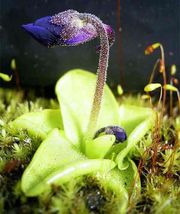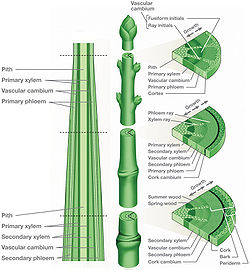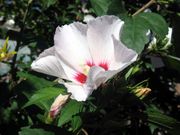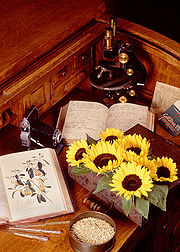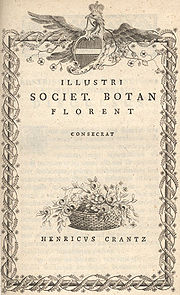Introduction to Botany
Contents
- Scope and importance of botany
- Human nutrition
- Fundamental life processes
- Medicine and materials
- Environmental changes
- Etymology
- History
- Early botany
- Medieval botany
- Early modern botany
- Modern botany
- Subdisciplines of Botany
- Notable Botanists
- See also
- References
- Notes
- Bibliography
- Popular science
- Academic and scientific
Scope and importance of botany
As with other life forms in biology, plant life can be studied from different perspectives, from the molecular, genetic and biochemical level through organelles, cells, tissues, organs, individuals, plant populations, and communities of plants. At each of these levels a botanist might be concerned with the classification (taxonomy), structure (anatomy and morphology), or function (physiology) of plant life.Historically all living things were grouped as animals or plants, and botany covered all organisms not considered animals. Some organisms once included in the field of botany are no longer considered to belong to the plant kingdom – these include fungi (studied in mycology), lichens (lichenology), bacteria (bacteriology), viruses (virology) and single-celled algae, which are now grouped as part of the Protista.
However, attention is still given to these groups by botanists, and fungi, lichens, bacteria and photosynthetic protists are usually covered in introductory botany courses.
» Produce food to feed an expanding population
» Understand fundamental life processes
» Produce medicine and materials to treat diseases and other ailments
» Understand environmental changes more clearly
Human nutrition
Virtually all foods eaten come from plants, either directly from staple foods and other fruit and vegetables, or indirectly through livestock or other animals, which rely on plants for their nutrition. Plants are the fundamental base of nearly all food chains because they use the energy from the sun and nutrients from the soil and atmosphere and convert them into a form that can be consumed and utilized by animals; this is what ecologists call the first trophic level. Botanists also study how plants produce food we can eat and how to increase yields and therefore their work is important in mankind's ability to feed the world and provide food security for future generations, for example through plant breeding. Botanists also study weeds, plants which are considered to be a nuisance in a particular location. Weeds are a considerable problem in agriculture, and botany provides some of the basic science used to understand how to minimize 'weed' impact in agriculture and native ecosystems. Ethnobotany is the study of the relationships between plants and people.Fundamental life processes
Plants are convenient organisms in which fundamental life processes (like cell division and protein synthesis for example) can be studied, without the ethical dilemmas of studying animals or humans. The genetic laws of inheritance were discovered in this way by Gregor Mendel, who was studying the way pea shape is inherited. What Mendel learned from studying plants has had far reaching benefits outside of botany. Additionally, Barbara McClintock discovered 'jumping genes' by studying maize. These are a few examples that demonstrate how botanical research has an ongoing relevance to the understanding of fundamental biological processes.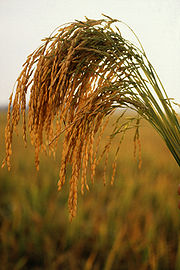
Nearly all the food we eat comes (directly and indirectly) from plants like this American long grain rice
Medicine and materials
Many medicinal and recreational drugs, like tetrahydrocannabinol, caffeine, and nicotine come directly from the plant kingdom. Others are simple derivatives of botanical natural products; for example aspirin is based on the pain killer salicylic acid which originally came from the bark of willow trees. There may be many novel cures for diseases provided by plants, waiting to be discovered. Popular stimulants like coffee, chocolate, tobacco, and tea also come from plants. Most alcoholic beverages come from fermenting plants such as barley (beer), rice (sake) and grapes (wine). Plants also provide us with many natural materials, such as cotton, wood, paper, linen, vegetable oils, some types of rope, and rubber. The production of silk would not be possible without the cultivation of the mulberry plant. Sugarcane, rapeseed, soy and other plants with a highly-fermentable sugar or oil content have recently been put to use as sources of biofuels, which are important alternatives to fossil fuels, see biodiesel.Environmental changes
Plants can also help us understand changes in on our environment in many ways.» Understanding habitat destruction and species extinction is dependent on an accurate and complete catalog of plant systematics and taxonomy.
» Plant responses to ultraviolet radiation can help us monitor problems like the ozone depletion.
» Analyzing pollen deposited by plants thousands or millions of years ago can help scientists to reconstruct past climates and predict future ones, an essential part of climate change research.
» Recording and analyzing the timing of plant life cycles are important parts of phenology used in climate-change research.
» Lichens, which are sensitive to atmospheric conditions, have been extensively used as pollution indicators.
In many different ways, plants can act a little like the 'miners canary', an early warning system alerting us to important changes in our environment. In addition to these practical and scientific reasons, plants are extremely valuable as recreation for millions of people who enjoy gardening, horticultural and culinary uses of plants every day.
Etymology
From Greek βοτάνη = "pasture, grass, fodder", perhaps via the idea of a livestock keeper needing to know which plants are safe for livestock to eat.History
Early botany
Ancient India
Early examples of plant taxonomy occur in the Rigveda, that divides plants into Vaska (tree), Osadhi (herbs useful to humans) and Virudha (creepers). which are further subdivided. The Atharvaveda divides plants into eight classes, Visakha (spreading branches), Manjari (leaves with long clusters), Sthambini (bushy plants), Prastanavati (which expands); Ekasanga (those with monopodial growth), Pratanavati (creeping plants), Amsumati (with many stalks), and Kandini (plants with knotty joints). The Taittiriya Samhita and classifies the plant kingdom into vaksa, vana and druma (trees), visakha (shrubs with spreading branches), sasa (herbs), amsumali (a spreading or deliquescent plant), vratati (climber), stambini (bushy plant), pratanavati (creeper), and alasala (those spreading on the ground).Manusmriti – Law book of Hindus – proposed a classification of plants in eight major categories. Charaka Samhitā and Sushruta Samhita and the Vaisesikas also present an elaborate taxonomy.
Parashara, the author of Vaksayurveda (the science of life of trees), classifies plants into Dvimatrka (Dicotyledons) and Ekamatrka (Monocotyledons). These are further classified into Samiganiya (Fabaceae), Puplikagalniya (Rutaceae), Svastikaganiya (Cruciferae), Tripuspaganiya (Cucurbitaceae), Mallikaganiya (Apocynaceae), and Kurcapuspaganiya (Asteraceae).
Important medieval Indian works of plant physiology include the Prthviniraparyam of Udayana, Nyayavindutika of Dharmottara, Saddarsana-samuccaya of Gunaratna, and Upaskara of Sankaramisra.
Ancient China
In ancient China, the recorded listing of different plants and herb concoctions for pharmaceutical purposes spans back to at least the Warring States (481 BC-221 BC). Many Chinese writers over the centuries contributed to the written knowledge of herbal pharmaceutics. There was the Han Dynasty (202 BC-220 AD) written work of the Huangdi Neijing and the famous pharmacologist Zhang Zhongjing of the 2nd century. There was also the 11th century scientists and statesmen Su Song and Shen Kuo, who compiled treatises on herbal medicine and included the use of mineralogy.Greco-Roman world
Among the earliest of botanical works in Europe, written around 300 B.C., are two large treatises by Theophrastus: On the History of Plants (Historia Plantarum) and On the Causes of Plants. Together these books constitute the most important contribution to botanical science during antiquity and on into the Middle Ages. Aristotle also wrote about plants.The Roman medical writer Pedanius Dioscorides (ca.40-90) provides important evidence on Greek and Roman knowledge of medicinal plants. Dioscorides is famous for writing a five volume book in his native Greek Περί ύλης ιατρικής (De Materia Medica - in the Latin translation) that is one of the most influential herbal books in history. In fact it remained in use until about CE 1600. Approximately 1300-1400 different plant species were known under Roman reign.
Medieval botany
The Kurdish biologist Al-Dinawari (828-896) is considered the founder of Arabic botany for his Book of Plants, in which he described at least 637 plants and discussed plant evolution from its birth to its death, describing the phases of plant growth and the production of flowers and fruit.Theophrastus’s Historia Plantarum served as a reference point in botany for many centuries, and was further developed around 1200 by Giovanni Bodeo da Stapelio, who added a commentarius and drawings: see Historia Plantarum —Selected pages of a 17th century edition of the 1200 version (in Italian).
In the early 13th century, the Andalusian-Arabian biologist Abu al-Abbas al-Nabati developed an early scientific method for botany, introducing empirical and experimental techniques in the testing, description and identification of numerous materia medica, and separating unverified reports from those supported by actual tests and observations. His student Ibn al-Baitar (d. 1248) wrote a pharmaceutical encyclopedia describing 1,400 plants, foods, and drugs, 300 of which were his own original discoveries. A Latin translation of his work was useful to European biologists and pharmacists in the 18th and 19th centuries.
Early modern botany
German physician Leonhart Fuchs (1501–1566) was one of the three founding fathers of botany, along with Otto Brunfels (1489- 1534) and Hieronymus Bock (1498-1554) (also called Hieronymus Tragus).Valerius Cordus (1515–1554) authored one of the greatest pharmacopoeias and one of the most celebrated herbals in history, Dispensatorium (1546). As early as the 16th century, the Italian Ulisse Aldrovandi was scientifically researching plants. In 1665, using an early microscope, Robert Hooke discovered cells in cork, and a short time later in living plant tissue. The Germans Jakob Theodor and Leonhart Fuchs, the Swiss Conrad von Gesner, and the British authors Nicholas Culpeper and John Gerard published herbals that gave information on the medicinal uses of plants.
During the 18th century systems of classification became deliberately artificial and served only for the purpose of identification. These classifications are comparable to diagnostic keys, where taxa are artificially grouped in pairs by few, easily recognisable characters. The sequence of the taxa in keys is often totally unrelated to their natural or phyletic groupings. In the 18th century an increasing number of new plants had arrived in Europe, from newly discovered countries and the European colonies worldwide, and a larger amount of plants became available for study.
The increased knowledge on anatomy, morphology and life cycles, lead to the realization that there were more natural affinities between plants, than the sexual system of Linnaeus indicated. Adanson (1763), Jussieu (1789), and Candolle (1819) all proposed various alternative natural systems that were widely followed. The ideas of natural selection as a mechanism for evolution required adaptations to the Candollean system, which started the studies on evolutionary relationships and phylogenetic classifications of plants.
Modern botany
A considerable amount of new knowledge today is being generated from studying model plants like Arabidopsis thaliana. This weedy species in the mustard family was one of the first plants to have its genome sequenced. The sequencing of the rice (Oryza sativa) genome and a large international research community have made rice the de facto cereal/grass/monocot model. Another grass species, Brachypodium distachyon is also emerging as an experimental model for understanding the genetic, cellular and molecular biology of temperate grasses. Other commercially-important staple foods like wheat, maize, barley, rye, pearl millet and soybean are also having their genomes sequenced. Some of these are challenging to sequence because they have more than two haploid (n) sets of chromosomes, a condition known as polyploidy, common in the plant kingdom. Chlamydomonas reinhardtii (a single-celled, green alga) is another plant model organism that has been extensively studied and provided important insights into cell biology.In 1998 the Angiosperm Phylogeny Group published a phylogeny of flowering plants based on an analysis of DNA sequences from most families of flowering plants. As a result of this work, major questions such as which families represent the earliest branches in the genealogy of angiosperms are now understood. Investigating how plant species are related to each other allows botanists to better understand the process of evolution in plants.
Subdisciplines of Botany
» Agronomy—Application of plant science to crop production» Bryology—Mosses, liverworts, and hornworts
» Economic botany—Study of plants of economic use or value
» Ethnobotany—Relationship between humans and plants
» Forestry—Forest management and related studies
» Horticulture—Cultivated plants
» Lichenology—The study of lichens
» Paleobotany—Fossil plants
» Palynology—Pollen and spores
» Phycology—Algae
» Phytochemistry—Plant secondary chemistry and chemical processes
» Phytopathology—Plant diseases
» Plant anatomy—Cell and tissue structure
» Plant biotechnology —Present technology used in different subdisciplines in plant science
» Plant breeding —Hybridization in plants
» Plant ecology—Role of plants in the environment
» Plant morphology—Structure and life cycles
» Plant physiology—Life functions of plants
» Plant systematics—Classification and naming of plants
Notable Botanists
» Ibn al-Baitar (d. 1248), Andalusian-Arab scientist, botanist, pharmacist, physician, and author of one of the largest botanical encyclopedias.» Aimé Bonpland (1773-1858), French explorer and botanist, who accompanied Alexander von Humboldt during five years of travel in Latin America.
» Luther Burbank (1849-1926), American botanist, horticulturist, and a pioneer in agricultural science.
» Augustin Pyramus de Candolle He originated the idea of "Nature's war", which influenced Charles Darwin.
» first name needed al-Dinawari (828-896), Kurdish botanist, historian, geographer, astronomer, mathematician, and founder of Arabic botany.
» David Douglas (1799-1834), Scottish botanical explorer of North America and China, who imported many ornamental plants into Europe.
» Joseph Dalton Hooker (1817-1911), English botanist and explorer. Second winner of Darwin Medal.
» Thomas Henry Huxley (1825-1895), English biologist, known as "Darwin's Bulldog" for his advocacy of Charles Darwin's theory of evolution. Third winner of Darwin Medal.
» Carl Linnaeus (1707-1778), Swedish botanist, physician and zoologist who laid the foundations for the modern scheme of Binomial nomenclature. He is known as the father of modern taxonomy, and is also considered one of the fathers of modern ecology.
» Gregor Johann Mendel (1822-1884), Augustinian priest and scientist, and is often called the father of genetics for his study of the inheritance of traits in pea plants.
» Abu al-Abbas al-Nabati (c. 1200), Andalusian-Arab botanist and agricultural scientist, and a pioneer in experimental botany.
» Richard Spruce (1817-1893), English botanist and explorer who carried out a detailed study of the Amazon flora.
» Agustín Stahl (1842-1917), conducted investigations and experiments in the fields of ethnology, and zoology in the Caribbean region.
» George Ledyard Stebbins, Jr. Widely regarded as one of the leading evolutionary biologists of the 20th century, developed a comprehensive synthesis of plant evolution incorporating genetics.
» Leonardo da Vinci (1452-1519), Italian polymath; a scientist, mathematician, engineer, inventor, anatomist, painter, sculptor,architect, botanist, musician and writer.
See also
» History of plant systematics» History of phycology
» Botanical garden and List of botanical gardens
» Dendrochronology
» List of domesticated plants
» Edible Flowers
» Flowers and List of flowers
» Forestry
» Herbs
» List of botanical journals
» List of botanists
» List of botanists by author abbreviation
» List of systems of plant taxonomy
» List of publications in biology
» Paleobotany
» Palynology
» Plant anatomy
» Seeds
» Plant physiology
» Plant community
» Plant sexuality
» Soil science
» Trees
» Vegetation
» Weed Science
» Zoology
References
- Chapman, Jasmin; Jones, Alan M.; Walsh, Ed; McDonald, Averil; Elizabeth Murphy, Jan; O'Brien, Pat. Science Web. Nelson Thornes Ltd. pp. 56.- Mann, J. (1987). Secondary Metabolism, 2nd ed.. Oxford: Oxford University Press. pp. 186–187.
- Fahd, Toufic, "Botany and agriculture", pp. 815 , in Morelon, Régis & Roshdi Rashed (1996), Encyclopedia of the History of Arabic Science, vol. 3, Routledge.
- Huff, Toby (2003), The Rise of Early Modern Science: Islam, China, and the West, Cambridge University Press, p. 218.
- Diane Boulanger (2002), "The Islamic Contribution to Science, Mathematics and Technology", OISE Papers, in STSE Education, Vol. 3.
- Valerius Cordus | Science and Its Times: 1450-1699
- Hoek, C.van den, Mann, D.G. and Jahns, H.M. 2005. Algae: An Introduction to Phycology. Cambridge University Press, Cambridge.
Bibliography
Popular science- Attenborough, David The Private Life of Plants.
- Capon, B: Botany for Gardeners
- Cohen, J. How many people can the earth support? W.W. Norton 1995
- Halle, Francis. In praise of plants ISBN 0-88192-550-0. English translation of a poetic advocacy of plants.
- King, J. Reaching for the sun: How plants work
- Pakenham, T: Remarkable Trees of the World (2002)
- Pakenham, T: Meetings with Remarkable Trees (1996)
- Pollan, M The Botany of Desire: A Plant's-eye View of the World Bloomsbury
- Thomas, B.A.: The evolution of plants and flowers St Martin's Press 1981
- Walker, D. Energy, Plants and Man ISBN 1-870232-05-4 A presentation of the basic concepts of photosynthesis
Academic and scientific
- Buchanan, B.B., Gruissem, W & Jones, R.L. (2000) Biochemistry & molecular biology of plants. American Society of Plant Physiologists.
- Crawford, R. M. M. (1989). Studies in plant survival. Blackwell.
- Crawley, M. J. (1997). Plant ecology. Blackwell Scientific.
- Ennos, R and Sheffield, E Plant life, Blackwell Science, Introduction to plant biodiversity
- Everitt, J.H.; Lonard, R.L., Little, C.R. (2007). Weeds in South Texas and Northern Mexico. Lubbock: Texas Tech University Press.
- Fitter, A & Hay, R Environmental physiology of plants 3rd edition Sept 2001 Harcourt Publishers, Academic Press
- Lambers, H., Chapin, F.S. III and Pons, T.L. 1998. Plant Physiological Ecology. Springer-Verlag, New York. ; 2nd compltely revised edition to appear in 2008.
- Lawlor, D.W. (2000) Photosynthesis BIOS
- Matthews, R. E. F. Fundamentals of plant virology Academic Press,1992.
- Mauseth, J.D.: Botany : an introduction to plant biology. Jones and Bartlett Publishers, A first year undergraduate level textbook
- Morton, A.G. (1981). History of Botanical Science.Academic Press, London.
- Raven, P.H, Evert R.H and Eichhorn, S.E: Biology of Plants, Freeman. , A first year undergraduate level textbook
- Richards, P. W. (1996). The tropical rainforest. 2nd ed. C.U.P. (Pbk)
- Ridge, I. (2002) Plants Oxford University Press
- Salisbury, FB and Ross, CW: Plant physiology Wadsworth publishing company
- Stace, C. A. A new flora of the British Isles. 2nd ed. C.U.P.,1997.
- Strange, R. L. Introduction to plant pathology. Wiley-VCH, 2003.
- Taiz, L. & Zeiger, E. (1998). Plant physiology. 3rd ed. August 2002 Sinauer Associates.
- Walter, H. (1985). Vegetation of the earth. 3rd rev. ed. Springer.
- Willis, K (2002) The evolution of plants Oxford University Press
